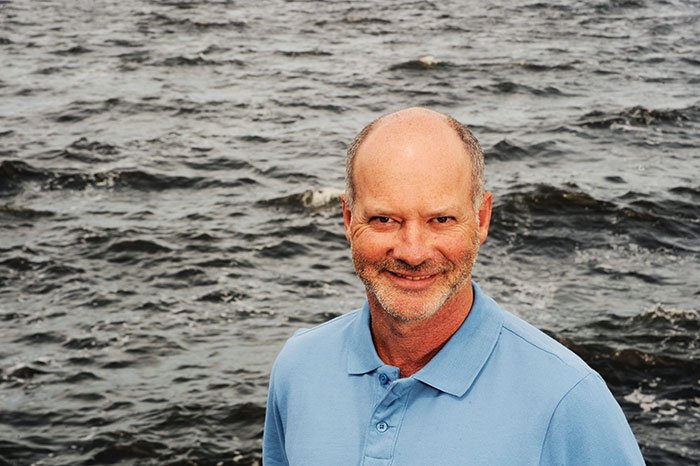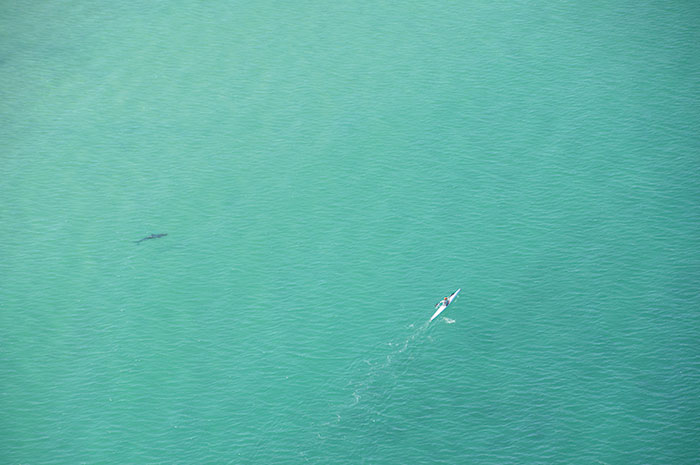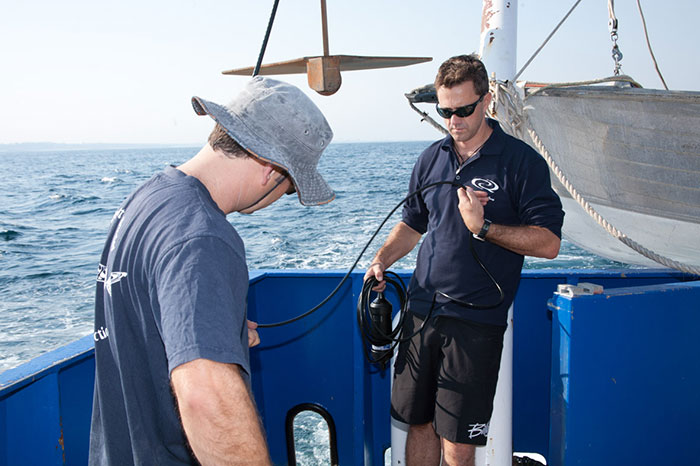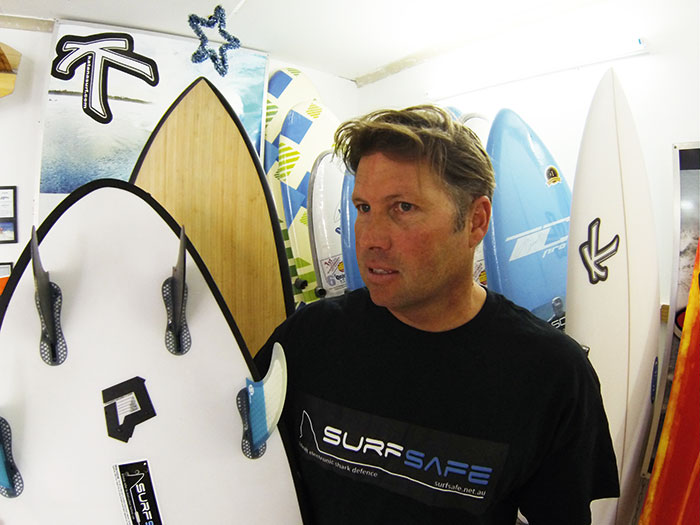With kill orders set to become the norm, what will it take to shift WA’s reputation as the shark-attack capital of the world?
There is something about a close encounter with a White Shark that can challenge hard facts as well as popular fiction. On a balmy November morning in 2012, I walked the South City Beach shoreline with my daughter as she prepared for an ocean swim. Mother: "I reckon stay inside the break, considering the shark risk". Daughter: (Sniffs) "You should worry about cars, not sharks."
The Surf Life Saving helicopter, which a moment earlier had swooped low above our heads, turned westward over the water and began to track towards the shore. It made two or three tight circles immediately above a spot of cerulean water about 100m from where we stood. No giveaway fin, no fast-moving shadow, but minutes later a ranger's order to stay clear of the water confirmed that a 3.5m shark was indeed out there, just beyond the break.
Last summer, I spoke with a young surfer who had the previous week photographed a 4m White Shark toying with a buoy off Leighton Beach. He was preparing to surf with his dad at a well-known break near Yallingup, despite an unconfirmed White Shark sighting at a nearby bay 20 minutes earlier. Assuming the animal was tracking south, as was reported, and cruising at its average 3.2km per hour, it might well have been approaching that very bay. They went back in anyway.
These days, even beyond the obvious headlines, there is ample evidence to suggest that more White Sharks are present in the world's shark-attack capital. It's easy to understand why last summer Premier Colin Barnett sought to reassure the public with his now infamous – if ill-advised – decision to appear in the media brandishing a giant shark hook. After all, how better to graphically demonstrate decisive action? But many observers wondered whether political imperative rather than sound science lay behind the move.
The issue of risk and what to do about the threat of White Shark attacks in WA waters continues to divide families and polarise otherwise rational friends like almost nothing else before or since. The Premier has described his now-overturned drum-line policy decision as the toughest of his political career – and even in the lingering shadow of the bitter James Price Point dispute, few would disbelieve him. What is difficult to believe is just how personally many West Australians – even reasonable, educated souls – have taken the issue of quite what to do about sharks.
There is the whiff of gun-lobby vitriol among those convinced of the state's right to defend against a menace that has, since 2000, taken 11 human lives and, most recently, permanently disabled a young surfer east of Esperance. Equally, death threats were liberally made against 'Cullin' ' Barnett's shark 'hunters'.

CSIRO shark expert Dr Barry Bruce.
Like so many issues that get people hot under the collar, it is easy to let the facts of this problem get in the way of a ripping yarn. You could be forgiven for assuming that, with so much argy-bargy, at least one side is in possession of the facts. But you would be wrong. The country's foremost White Shark expert, Dr Barry Bruce, told me back in 2007 that it was impossible to know how many sharks are cruising the waters off our coast. "Anyone who says there is a certain number of White Sharks is speaking through their backside," the CSIRO marine research scientist said at the time. Seven years later, we seem no closer to answering the questions: are there more White Sharks out there, and do more sharks necessarily mean a greater risk of attack?
Research now indicates that there are two distinct populations of Australian White Sharks; an East Coast group and a WA-South Australian population.
Says WA Fisheries' Dr Rory McAuley: "This new understanding, that we are probably dealing with two populations, throws the status of the WA/SA population wide open." It begs the question, too: was the decision to list White Sharks as vulnerable based on data from the WA-based population or the East Coast?
Barry Bruce insists the data came from all around the country, and the decision to list the sharks as vulnerable was taken primarily as a precaution, even though no robust estimates of population size were available – and still aren't.

Numbers aside, you would be hard pressed to find a single credible marine expert willing to concur with the oft-repeated mantra that the 1997 national White Shark recovery program has run its course. Anecdote is one thing; hard evidence quite another. It doesn't help that scientists are yet to agree on specifically what 'recovery' means. But there is agreement that the distribution of these sharks can and often does vary wildly from one year to another, which goes some way towards explaining apparent surges in activity.
"People say, 'Lots of White Sharks this year – the population must have recovered'," says Barry Bruce.
"It takes more than a year to recover; it is hard to interpret reports of 'seeing more White Sharks in an area' – this can often mean that somewhere else is 'seeing less of them'."
"There's a common belief that the obvious explanation for very high frequency of attacks during 2011-2012 is an increase in the overall population size of White Sharks," says Rory McAuley. "One of many theories is that there were more White Sharks in WA during that period. Or there could have been more close to shore or close to populated areas during those periods."
Warnboro Sound is one stretch of water where scientists have identified an apparent White Shark trend, he says. "We tend to get more reports of White Sharks in areas, and at times when there is some sort of plausible prey-availability explanation. For example, in 2000-2001, we started hearing reports of White Sharks occurring routinely during December-January. We now know that there is a snapper aggregation down there at that time."
Beyond the vexed question of whether or not White Shark numbers are back on track, the issue of increasing incidents of attack is more complex and nuanced than a simple matter of cause and effect.
Rory McAuley says WA is part of an international collaboration funded by the Canadian Government, aimed at better understanding large-scale movements and distribution of marine species, particularly in response to climate change.
It is still early days, but if White Sharks are changing their movements as a result of large-scale environmental drivers, it could explain apparent absences in some years and surges in others. What's more, if they are responding to these factors, then monitoring conditions off our coast may help predict attacks.
Meanwhile, a nationwide shark tagging program is yielding fascinating data aimed at keeping our beaches safer. The program has seen 346 sharks tagged and tracked, exposing their movements online in tantalising detail. But, to the dismay of many, only a small proportion of these are White Sharks, and only one – a 5m monster tagged at King George Sound in March 2014 – a breeding female.

Still, the tagging program has helped to identify shark 'feeding frenzies' in our
waters, shedding light on the mystery of apparent surges in activity.
"These events probably happen up and down the coastline all the time," says Rory McAuley. "The interesting public safety element was that we had a means of identifying the factors that were leading the sharks to remain in the area for a reasonably extended period of time. Those sharks gave us early warning of the conditions that might lead to sharks coming into contact with humans."
Indeed, the movements of sharks are anything but random.
"They seem to know where to be to take advantage of biological hotspots – places to feed," says Barry Bruce. "In some places they seem to follow the same corridors."
Tracking of tagged sharks shows there is a common navigation path in deep water at the end of the Continental Shelf. The big question is what brings these giant opportunists, biologically primed to respond to changes in the marine environment, so close to shore. Contrary to popular myth, it has little to do with seals.
There is evidence to suggest that White Sharks regularly enter shallow waters off the WA coast in pursuit of aggregations of their favourite foods: mulloway, salmon, snapper, dhufish and mullet. The experts say this is entirely normal behaviour and always has been – and most of the time it goes unnoticed.
But, what does it mean in terms of risk?
It is now clear that winter and spring bring more sharks to our coast. Summer appears to be a different matter. A 2014 study into shark bite risk by UWA's Department of Emergency Medicine rated the danger of swimming in shallow water within 25m of the shore during summer as "very low" – well below the risk of other common recreational activities in WA. However, surfing or diving offshore in the south-west during winter and spring carries a fatal shark bite risk up to 10 times that of a serious or fatal recreational cycling crash.
When WA environmental watchdog the Environmental Protection Authority sought advice on whether or not to recommend approval for the drum-line program, hard data on these top-order predators was difficult to come by. How could it recommend in favour of a program targeting a species that nobodyknows very much about? Never mind that the drumlines – baited hooks suspended from the ocean floor – mostly caught relatively harmless Tiger Sharks, doing little more than providing feverish social media activists with abundant footage of drowned, shot or otherwise deceased animals sinking into the blue off Rottnest. Dr Jessica Meeuwig, of UWA's Oceans Institute, pointed out the irony that this was a species that annually migrated past Perth en route to Palau, to furnish that country's burgeoning shark-dive industry.
The recent attack near Esperance, in which surfer Sean Pollard lost both hands, may well turn opponents of the drum-line program in its favour. It is the first time in WA that an attack has prompted the successful baiting and destruction of a White Shark – two White Sharks in this case. The jury is likely to remain out regarding whether or not one, or indeed both, were responsible for Pollard's devastating injuries in October 2014. It may not even matter. For a growing number of West Australians, any dead White Shark translates to a safer ocean, a view in stark contrast to the opinions of so many shark-attack survivors.
The state has since withdrawn its application for Commonwealth approval of the drum-line program itself, but has the green light to catch and kill sharks deemed to pose a threat.
It's no act of vicarious fascination that shark experts get some of the most interesting and telling insights into shark behavior by talking to shark-attack survivors. It is generally Rory McAuley's assessment of items recovered from the scenes of these attacks – surfboards, wetsuits, bathers, surf skis – that determines
the species involved.

WA Fisheries' Dr Rory McAuley, right, cites prey availablility as a possible factor in increased shark presences.
He remains in contact with Elyse Frankcom, for example, a young woman who was attacked by a White Shark while snorkelling with Warnboro Sound dolphins in 2010.
In 2007 and 2008, I did a series of interviews with WA shark-attack survivors and witnesses. In the ensuing years, certain salient details of these extraordinary encounters remain with me like persistent ghosts: Allan Oppert's description of the White Shark that attacked him during a spear-fishing scuba dive off Binningup Beach in January 2004; Zac Golebiowski's heartbreaking regret about the shark that took his leg; the freakish behavior of marine life reported by witnesses just before surfer Bradley Smith was fatally mauled at Cowaramup Bay in July 2004. All are examples of an astonishing window into an otherwise darkly veiled world.
Allan Oppert said he was descending in deep water towards a 6m-wide, 3m-deep depression on the ocean floor, when he became aware of a giant shark in a 'crater' below him.
"Like a dog looking for (her) master... she can't see him, but can smell him," was how he described the shark's demeanour.
"She's going over to one spot and having a look, and going over to another and having a sniff. These sharks are like dogs, in their gestures and in their behavior. They hunch up their backs when they are annoyed... and she was annoyed."
A witness to Bradley Smith's death at Gracetown in 2004 told police he noticed that schools of fish in the water where he was surfing suddenly disappeared just before the attack.
Another witness reported "a huge school of dolphins came swimming through… They were all excited and jumping and catching the waves. The unusual part was there were a lot of smaller dolphins... One of the bigger dolphins jumped out of the water making a chortling noise."
Zac Golebiowski expressed a kind of incongruous remorse that the shark that took his leg, at a little cove 70km from Esperance one December morning in 2006, did not consume the limb.
"The guy from the caravan park found my leg a few days later; what is the point of
just biting it?" he told me, as if the answer might have explained – even justified in some small way – his devastating loss. Thus the oft-cited myth that White Sharks attack humans only "by accident".
Some time after my interview with Zac, I relayed to Barry Bruce an incident in 2007, during which the bottom half of a turtle – apparently bitten by a large shark – turned up on Swanbourne Beach. Was it evidence that sharks reject parts of other prey as well?
"We see the same pattern of attacks on people that we see on seals," said Barry at the time. "Some seals get bitten and spat out. Some seals get consumed. There are echoes of this behaviour on land as well."
And what of Zac's habit of drumming out rhythms on his board with his fingers as he waited for waves? Could it explain why the animal that took his leg swam beneath one of two other surfers before perhaps homing in on this novel sound? Was a similar phenomenon at play on the November 2000 morning at North Cottesloe Beach when a 4.5m monster, having fatally attacked Ken Crew, swam within an arm's length of swimmer Ann Vincent, knocking her off her feet, and heading instead to attack Dirk Avery, who was much closer to the shore? A huge shark is known to have ignored many other swimmers and paddlers in the water that morning. A pair of surf-skiers reported that a creature the size of a family sedan swam under them at Vera View as it cruised towards North Cottesloe minutes before Ken Crew was killed. What distinguished Ken Crew from so many others in the water that morning?
Nothing, that the experts are aware of. "A lion attacking a herd of zebra won't blindly rush in to bite the first zebra it runs into – it selects," says Barry Bruce. "What makes any one individual the target is not known."
Even with advanced knowledge of the presence of White Sharks, tragedies have unfolded. There were many reports of big sharks in the water in the days before the recent attack near Esperance. And, while one of the two sharks culled following the incident was carrying a tag, there was no acoustic receiver along this stretch of coast to register its presence. Even evidence of sharks in the area in the preceding three weeks – including calls for warning signs to be erected on Esperance beaches – and the tagging of a possible culprit, didn't save Sean Pollard's precious hands.
It seems counterintuitive that a creature so ferocious could also be vulnerable. But in biological terms the White Shark certainly is.
The science indicates that mature females in Australia do not reproduce until they are 5m long, and they take about 20 years to grow that big. They reproduce – at best – every three years, and live to an estimated 60 years old. Compared to bony fish, which reproduce every year, a White Shark's reproductive opportunities are few, their natural mortality is low and they can't sustain any level of mortality that's non-natural.
An incidence of that natural mortality was captured for the first time in California in 1997, and showed that the sharks may not be so top-order after all. Footage depicting an Orca killing a White Shark coincided with reports that all the White Sharks in the area at the time of the attack had suddenly and inexplicably disappeared.
Esperance filmmaker and shark researcher Dave Riggs is not alone in his conviction that Killer Whales could hold the key to keeping beaches safer from White Shark attacks. He says many Orca experts believe that they occasionally predate on White Sharks, and that deploying Killer Whale audio in swimming areas could be a solution to the shark hazard.

Shark researcher David Riggs.
"I have hours of footage of Killer Whales hunting off Bremer Bay and there are always heaps of sharks around – but never White Sharks," he says.
He sent audio of Orcas hunting in February this year to researchers at UWA's Oceans Institute, who forwarded it to White Shark researchers in South Africa in May 2014. Tests quickly showed great promise, but more research is desperately needed if further tragic incidents are to be avoided, he says.
Which leads us back to that fortuitous intervention on South City Beach by the SLSWA helicopter. Could it have averted a tragedy? Perhaps. But there can be no certainties where shark behavior is concerned.
"There are plenty of observations from the air of large sharks in amongst surfers," says Barry Bruce. "The surfers have not had a problem; they don't know (the sharks) are there. We've seen seals swimming with White Sharks and the seals seem to know when they are in hunting mode and when they are not."
Which bring us to the myth about sharks being perpetually on the hunt.
"Sharks are like lions," he says. "Most of the time they are in resting mode." If only we knew what seals know.
For jittery western suburbs ocean lovers a so-called 'shark barrier' – or underwater PVC fence, successfully trialled in Dunsborough – could soon help alleviate fears. Priced at $130,000 a year for a three-year program in Cottesloe, it is a start.
At the same time, a promising new Commonwealth research 'toolkit' – combining tagging, aerial surveys and DNA fingerprinting – represents the best hope yet of determining shark numbers and the exact nature of the threat against their survival. The hope is that this will provide a more definitive understanding of sharks before the tide turns against them once and for all.
The role that these sharks play in the marine ecosystem is considered vital... but at the same time, few would argue the importance of keeping our surfers, swimmers, scuba divers and other ocean users safe. As gorgeous – and indeed, wild – as our prized beaches and bays are, they remain the sharks' natural environment. Now, more than ever before, good science and common sense must prevail.
How To Avoid Sharks
(Courtesy of the Surf Life Saving WA website)
-
Avoid large schools of fish, dolphins, seals or sea lions, and areas close to bird rookeries.
-
Avoid areas where animal, human or fish waste enters the water.
-
Avoid deep channels or areas with deep drop-offs nearby.
-
Do not remain in the water with bleeding wounds.
-
Look carefully before jumping into the water from a boat or jetty.
-
If spearing fish, remove all speared fish from the water as quickly as possible.
-
If schooling fish or other wildlife start to behave erratically or congregate in large numbers, leave the water.
-
If you see a shark, leave the water quickly and calmly – avoid excessive splashing or noise.

Dave Smith created his own Surfsafe device.
Do Shark Sheilds Work
Perth surfboard maker Dave Smith became so tired of worrying about sharks that he took matters into his own hands. Plowing more than $130,000 in private funds into research and development, he came up with a device to help keep surfers safe. He says products already on the market are unwieldy and have inherent problems including unwanted electrical charges, so he successfully applied for a scientific permit to exempt him from Australian and New Zealand laws regarding White Shark research. Next came a series of research projects in WA and New Zealand where he tested his Surfsafe device. The product emits electrical pulses from electrodes at a frequency that has been shown to keep White Sharks away from their favourite food. The device is imbedded in the body of a surfboard, and turns on as soon as it hits the water. At the time of going to print, Dave had sold 68 of the devices in the preceding six weeks. He compares the machine's safety to wearing a seatbelt or crash helmet. "It is designed to increase your chances of survival; nothing is guaranteed against a wild animal but I am 100 per cent confident for my children, my customers and the surfing community to use it." So confident that he now happily surfs at the most "sharky" breaks, such as Rottnest's Cathedral Rocks. Meanwhile, Shark Shields, commonly used by WA scuba divers continue to be in high demand. And there seems to be plenty of evidence that they work, even in bloodied, baited waters. For more information, visit surfsafe.net.au and sharkshield.com/faq.
See a giant white shark near Esperance:
Watch sharks off Rottnest: